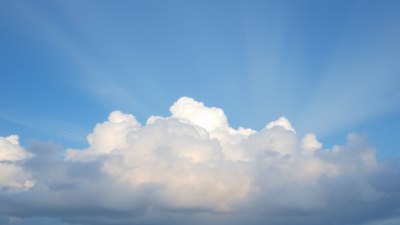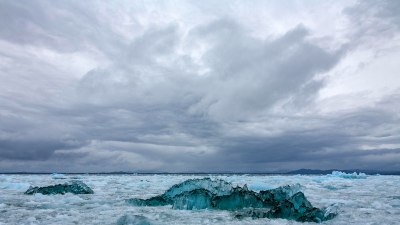The Role of Dust and Pollen in Cloud Formation
Explore how dust and pollen particles contribute to cloud formation and influence weather patterns worldwide.

Clouds are an essential component of Earth's atmosphere, influencing weather, climate, and the hydrological cycle. While commonly perceived as mere collections of water droplets or ice crystals, clouds actually owe their formation to the presence of tiny particles suspended in the air known as cloud condensation nuclei (CCN). Among these microscopic particles, dust and pollen play crucial roles in initiating and sustaining cloud formation. Understanding their contribution sheds light on complex atmospheric processes and helps improve weather forecasting and climate models.
Understanding Cloud Formation Basics
Cloud formation begins when moist air rises and cools, causing water vapor to condense into liquid water or ice. However, for condensation to occur efficiently, water vapor requires a surface upon which to transition from gas to liquid phase. This surface is provided by aerosols—minute particles suspended in the atmosphere that serve as cloud condensation nuclei. Without these nuclei, water molecules would remain in vapor state even if the air reached saturation or beyond.
Common sources of CCN include sea salt, soot, sulfates, dust, and biological particles like pollen. The physical and chemical properties of these particles, such as size, hygroscopicity (ability to attract water), and surface chemistry, significantly influence the efficiency of cloud droplet formation. Dust and pollen, originating from natural processes, are notable for their role in this atmospheric phenomenon.
Dust Particles as Cloud Condensation Nuclei
Dust originates from arid and semi-arid regions worldwide, lifted into the atmosphere by winds and storms. These mineral particles can be transported vast distances, crossing continents and oceans. Their importance in cloud formation derives from several factors:
Size and Surface Area: Dust particles typically range from submicron to several microns in diameter. Their substantial surface area provides ample sites for water vapor to nucleate, enabling cloud droplet initiation even under less-than-ideal humidity conditions.
Composition and Hygroscopicity: Mineral dust contains various salts and oxides that influence its water-attracting capability. Some dust particles are chemically coated or mixed with other compounds, enhancing their ability to absorb water and serve as CCN.
Ice Nucleation: Apart from liquid droplet formation, dust particles also serve as ice nucleating particles (INP). Certain dust minerals can promote ice crystal formation at higher temperatures than would occur without these nuclei, critical for cold cloud dynamics and precipitation development.
The Impact of Dust on Regional and Global Weather
Dust's influence on cloud formation extends beyond nucleation. Its interaction with radiation and cloud microphysics can modify weather and climate patterns:
Cloud Albedo Effect: Dust particles help create clouds that reflect sunlight back to space, affecting the Earth's energy balance. An increase in cloud brightness (albedo) can contribute to regional cooling.
Precipitation Patterns: Dust-induced cloud modifications can alter precipitation efficiency. In some cases, dust particles may lead to more numerous but smaller droplets, suppressing rainfall; in others, ice nucleation may enhance precipitation.
Long-Range Transport: Dust storms transporting particles across the Atlantic and Pacific oceans impact cloud formation far from their source regions, influencing weather in distant locations such as the Americas or Asia.
Pollen as a Biogenic Cloud Condensation Nucleus
While less studied than mineral dust, pollen grains represent a significant biogenic source of CCN in certain regions and seasons. Pollen is released by flowering plants and trees, often in massive quantities during spring and summer months.
Physical Characteristics: Pollen grains are generally larger than mineral dust particles, with diameters ranging from around 10 to 100 microns. This size helps them act as nuclei for cloud droplet formation, particularly in low-altitude clouds.
Surface Properties: The outer coating of pollen, called the exine, contains proteins and organic compounds that influence its interaction with water vapor. Some pollen types have hydrophilic surfaces aiding water condensation.
Biological Activity: Pollen may release smaller submicron particles or fragments that function as CCN. Additionally, enzymatic activity or microbial communities associated with pollen can modify local atmospheric chemistry impacting cloud nucleation.
Seasonal and Geographic Variations of Pollen’s Role
The effect of pollen on cloud formation is strongly season-dependent:
Spring/Summer Peak: During flowering seasons, regions with abundant vegetation experience high pollen concentrations, influencing local cloud properties. This impact is most pronounced in temperate forests, grasslands, and agricultural zones.
Tropical Environments: In tropical forests, pollen counts can be significant year-round, supporting consistent biogenic CCN availability.
Urban vs Natural Settings: Urban areas may see reduced pollen impact due to lower vegetation, while rural and wilderness zones exhibit stronger biogenic cloud effects.
Interactions Between Dust and Pollen in the Atmosphere
Dust and pollen coexist in the atmosphere and can interact in several ways to influence cloud formation:
Mixed Particle Formation: Electrostatic or chemical interactions may cause dust and pollen particles to aggregate, forming composite CCN with altered nucleation properties.
Competition and Synergy: The relative abundance of dust and pollen can affect cloud droplet populations and size distributions differently, sometimes leading to synergistic enhancements in cloud formation.
Atmospheric Processing: UV radiation, humidity changes, and atmospheric chemicals can modify dust-pollen mixtures, affecting their effectiveness as CCN or ice nuclei.
Research Methods for Studying Dust and Pollen Effects
Scientists employ various approaches to investigate how dust and pollen contribute to cloud formation, including:
Field Measurements: Ground stations, aircraft, and balloon-borne instruments collect aerosol samples and measure cloud microphysical properties in situ. Analysis includes particle size distribution, chemical composition, and cloud droplet characteristics.
Remote Sensing: Satellite-based instruments like MODIS and CALIPSO track dust plumes and pollen dispersal patterns. LIDAR and radar systems help monitor cloud formation linked to aerosol events.
Laboratory Experiments: Cloud chambers simulate atmospheric conditions to examine nucleation behavior of dust and pollen under controlled humidity and temperature.
Modeling: Atmospheric models incorporate aerosol-cloud interactions to predict cloud formation scenarios. Models test how varying dust and pollen concentrations impact cloud properties and precipitation.
Environmental and Climatic Implications
Understanding dust and pollen roles in cloud formation is vital for multiple reasons:
Climate Feedback Mechanisms: Changes in land use, desertification, or vegetation cover can alter dust and pollen emissions, influencing cloudiness and regional climate feedbacks.
Air Quality and Health: Dust and pollen can impact human health, while their cloud interactions modulate weather patterns affecting pollution dispersion and respiratory conditions.
Agricultural Cycles: Pollination coincides with cloud forming periods, linking ecosystem productivity, precipitation, and atmospheric processes.
Future Directions in Research
Advancements in aerosol science and climatology aim to improve understanding of these complex processes. Priority areas include:
Improved Measurement Techniques: Enhanced instrumentation for detecting and characterizing biological aerosols like pollen, including real-time monitoring and chemical analysis.
Integrating Multiscale Models: Coupling local and global models to better represent dust-pollen-cloud interactions and their climatic effects.
Impact of Climate Change: Investigating how warming temperatures and shifting precipitation patterns affect dust generation and pollen production, altering cloud formation dynamics.
Human Influence: Studying anthropogenic effects such as urbanization, land use change, and pollution on natural aerosol emissions and cloud processes.
Summary
The formation of clouds is a complex interplay between atmospheric moisture and microscopic particles like dust and pollen, which act as crucial nuclei for condensation. Mineral dust particles, lifted by winds from deserts and other arid areas, provide abundant surfaces that attract water molecules and initiate cloud droplet and ice crystal formation. Their chemical and physical properties directly impact regional weather and global climate through modifications of cloud albedo and precipitation.
Pollen grains, with their unique biological characteristics, serve as important biogenic CCN, particularly in vegetative and flowering seasons. They introduce organic surfaces and potential biological activity that alter nucleation processes, influencing cloud microphysics in specific geographic and seasonal contexts.
The dynamic interactions between dust and pollen and their transformation in the atmosphere add further complexity to cloud formation processes. Research employing field observations, laboratory experiments, remote sensing, and modeling continues to unravel these relationships, with implications for climate prediction and environmental management. As anthropogenic pressures and climate change evolve, the roles of these natural aerosols in cloud formation will remain vital areas of scientific inquiry.











